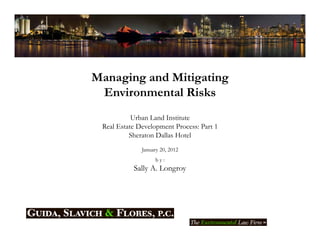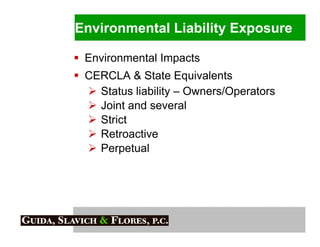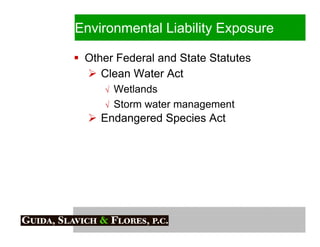Managing And Mitigating Environmental Risks - Urban Land Institute
- 1. Managing and Mitigating Environmental Risks Urban Land Institute Real Estate Development Process: Part 1 Sheraton Dallas Hotel January 20, 2012 by: Sally A. Longroy
- 2. Overview ’ü▒Environmental Liability Exposure ’ü▒Environmental Site Assessments ’ü▒Governmental Liability P t ti ’ü▒G t l Li bilit Protection ’ü▒Contractual Liability Protection ’ü▒Environmental Insurance
- 3. Environmental Liability Exposure ’é¦ Environmental Impacts ’é¦ CERCLA & State Equivalents ’āś Status liability ŌĆō Owners/Operators ’āś Joint and several ’āś Strict ’āś Retroactive ’āś Perpetual
- 4. Environmental Liability Exposure ’é¦ Other Federal and State Statutes ’āś Clean Water Act ŌłÜ Wetlands ŌłÜ Storm water management g ’āś Endangered Species Act
- 5. Environmental Liability Exposure ’é¦ Increased Development Costs ’āś Waste management ’āś Waste water ’āś Asbestos ’āś Wetlands ’āś Lead paint ’é¦ Land-use Restrictions ’é¦ Claims from Third Parties ’é¦ Unknown Environmental Conditions
- 6. Environmental Site Assessment ’é¦ All Appropriate Inquiry (Phase I) ’é¦ Identifies Recognized Environmental de es ecog ed o e a Conditions (RECs) ’é¦ Components ’āś Records review ’āś Site reconnaissance ’āśI t i Interviews ’āś Report ’āś Qualified environmental professional
- 7. Environmental Site Assessment ’é¦ AAI Does Not ’āś Radon Cover: ’āś Mold ’āś Petroleum ’āś Municipal solid waste ’āś Asbestos in buildings b ildi ’āś Wetlands ’āś Lead-based paint ’āś Endangered species ’āś Lead in drinkingg water ’āś A h l i l and Archeological d cultural ’āś Indoor air pollution/vapor g y ’āś Regulatory intrusion compliance
- 8. Environmental Site Assessment ’é¦ If Contamination Issues ŌåÆ Phase II Invasive Sampling of p g ’āś Soil ’āś Ground water ’āś Surface water ’āś Sediment ’é¦ Release Reporting Obligations
- 9. Governmental Liability Protection ’é¦ CERCLA Defenses ’āś Innocent Landowner ’āś Contiguous Property Owner ’āś Bona fide Prospective Purchaser p ’é¦ Requires ŌĆ£All Appropriate InquiryŌĆØ ’āś ASTM E1527-05 ŌĆō consistent with final rule on AAI ’āś Codified at 40 CFR Part 312
- 10. Governmental Liability Protection Texas Voluntary Cleanup Program ’é¦ Remediate to meet Texas standards ’é¦ Certificate of Completion ŌĆō releases future owners and lenders from liability to Texas ’é¦ Must apply before taking title ’é¦ Must apply before performing remediation
- 11. Governmental Liability Protection Texas Innocent Owner/Operator Program ’é¦ Immune from liability if ’āś Property contaminated by release or migration from off-site source or sources, and ’āś Did not cause or contribute to the source or sources of the contamination
- 12. Governmental Liability Protection Texas Innocent Owner/Operator Program ’é¦ IOP Certificate of Completion confirms eligibility ’é¦ IOP Certificates are not transferable
- 13. Governmental Liability Protection Texas Municipal Setting Designation p g g ’é¦ City ordinance restricts potable use of g groundwater ’é¦ Eliminates exposure pathway so may ’āś Lower cleanup standards ’āś Reduce investigation/remediation requirements ’āś Reduce remediation costs ’é¦ TCEQ certifies the ordinance
- 14. Contractual Liability Allocation ’é¦ Disclosure Obligations ’é¦ Remediation Agreements ’é¦ ŌĆ£As IsŌĆØ ’é¦ Li bilit R l Liability Release P i i Provisions ’é¦ Indemnity Provisions ’é¦ Successor Property Owner Problem
- 15. Environmental Insurance ’é¦ Clean Up Cost Cap ’āś may not be available ’é¦ Site Pollution Liability Insurance ’é¦ Green Building Restoration ’é¦ Storage Tank Liability Insurance
- 16. Trends Trends Thank You! Th k Y ! Questions & Answers Q Presented by: Sally A. Longroy















